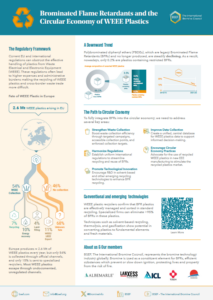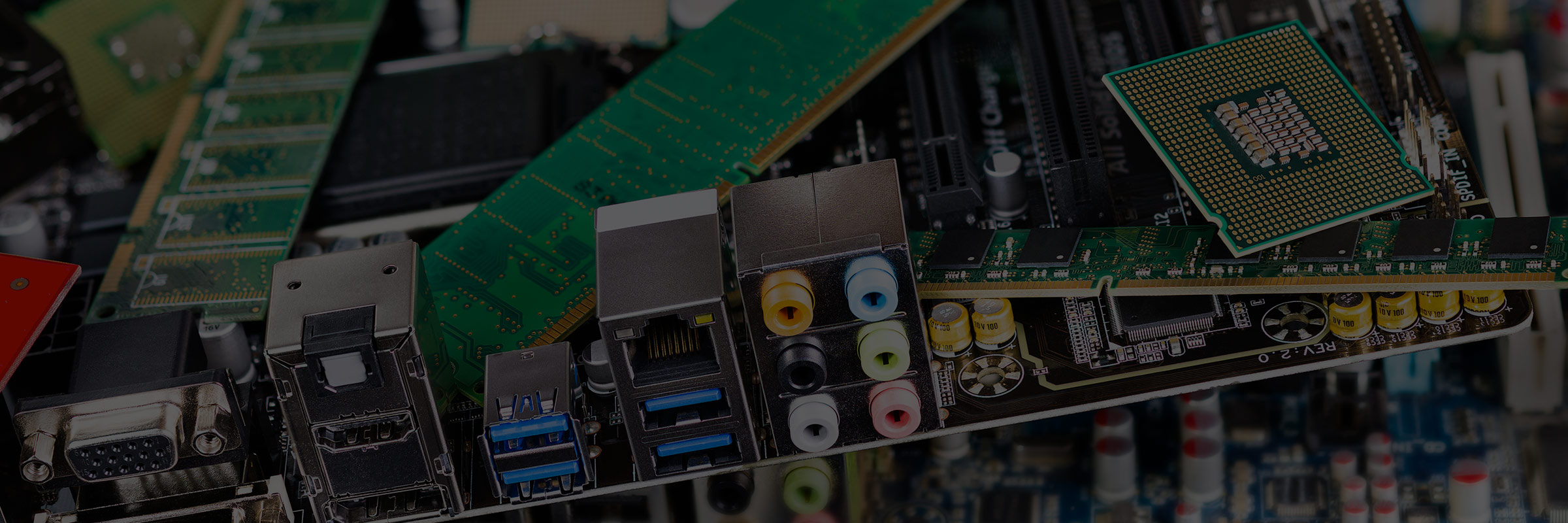
End of Life Management
Products with brominated flame retardants can undergo a number of waste management options at the end of their life. The choice depends on the amount and composition of the waste stream as well as on local conditions.
For many years, recycling of products containing brominated flame retardants has been possible and delivers very satisfying results2. Plastics with brominated flame retardants can have excellent stability during recycling which allows recycled plastics to meet the same levels of fire safety as virgin material. This maintains the value provided by flame retardants in the recycled plastic.
When recycling is not possible, a range of eco-efficient waste management options are possible, such as incineration with energy recovery, precious metal smelting, as well as chemical recycling leading to the recovery of bromine which allows the re-entry of this valuable resource into the circular economy.
The brominated flame retardant industry is committed to working closely with authorities, the value chain and other stakeholders to further encourage sustainable end of life solutions.
The brominated flame retardant industry is committed to working closely with authorities, the value chain and other stakeholders to further encourage sustainable end of life solutions
WEEE Plastics containing brominated flame retardants (BFRs)
According to European Electronics Recyclers Association (EERA), some 1.2 million tonnes of WEEE plastics arises each year in the EU of which 300,000 tonnes of this WEEE plastics are delivered to specialized plastics recycling facilities in the EU (2018). Only 5% of these plastics contain BFRs.
BFRs used in reactive[1] applications in electrical and electronic equipment, such as printed circuit boards, present no problem for WEEE recycling under controlled conditions. The printed circuit boards contain valuable precious and other metals and are separated and sent to specialized metal smelting/recovery operations. Here the metals are recovered, and the resin matrix is consumed as energy.
WEEE plastics are deemed to have restricted BFRs if no check is made showing that the plastics contain less than 2,000ppm bromine. This value is contained with a dedicated CEN standard EN 50625-3-1:2015 which sets general treatment requirements for cathode ray tube (CRT) due to the leaded/cesium containing glass and flat panel display (FPD) appliances due to the mercury containing plastics which may contain BFRs based on a threshold value of 2,000 ppm Br.
If WEEE plastics are checked according to this standard, and are below the 2,000ppm threshold for Br, then they can be recycled with other plastics as they are deemed free of restricted BFRs.
WEEE plastics with Br values above 2,000ppm are concentrated and then sent for either incineration, waste to energy or to cement kilns along with other non-recyclable plastics. In this way, the phased-out BFRs will also be soon removed from the overall material cycle.
In addition, as part of its global Circular Economy Action Plan, BSEF and its member companies are engaged in several projects and studies to improve end of life recycling of materials containing brominated flame retardants (BFRs).
The SMX’s marking technology for example will be used to differentiate current and new BFR technologies from the phased-out BFRs chemistry.
[1] Reactively added flame retardants are covalently bonded into the matrix of the polymer resin and thus cease to exist in the parent form
BROMINATED FLAME RETARDANTS ARE NOT HINDERING THE RECYCLING OF WEEE PLASTICS SAYS NEW STUDY
In 2023 BSEF presented the study “Brominated Flame Retardants and the Circular Economy of WEEE Plastics”, which has been undertaken in collaboration with the leading sustainability consultancy dss+ and represents an update of a first version published in 2020. The report reveals key insights into the present state of Waste Electrical and Electronic Equipment (WEEE) plastics recycling in Europe, showing how BFR-containing WEEE are currently integrated in the circular economy and proposing key recommendations on how to make electronic waste recycling more efficient and sustainable.
Through research and data, the study sheds light on misconceptions around the recycling of BFRs and demonstrates that the commitment of the industry to increasing products’ sustainability has been paying off.
Electronic and electrical equipment uses plastics to make products lighter, more innovative, and cost effective. Plastic components are inherently combustible and need to be protected from ignition. Brominated Flame Retardants are often used in plastics to meet fire safety standards and protect consumers from accidental fires. Brominated Flame Retardants are the most efficient group of chemistries as they can be used across many plastics, offering a high degree of performance, and choices for design.
POP Brominated Flame Retardants
and End of life
For waste treatment purposes, there are currently six “phased-out” brominated flame retardants (tetra- and penta-BDE; hexa- and hepta-BDE; deca-BDE and HBCD) that are restricted under the Stockholm Convention on Persistent Organic Pollutants (POPs Convention). From an end of life perspective, they are all subject globally to the Basel Convention where specific treatment techniques and importantly, Low POP Concentration Limits (LPCL) are set, above which the waste containing the POP must be disposed of in an environmentally sound manner. The table below shows the current LPCL values for HBCD and the sum of the PBDEs (both except deca-BDE and as present in c-decaBDE). The bracketed text indicates theproposed LPCL values according to the latest version of the General Technical Guidelines on POP waste, which are still under discussion in preparation of the 10th meeting of theConference of the Parties (July 2021).
The EU Regulation (recast) on Persistent Organic Pollutants (POPs Regulation) (EU) 2019/1021 has set in Annex IV (List of substances subject to waste management provisions) a LPCL of 1,000 mg/Kg for the sum of all PBDEs (including decaBDE). The Annex indicates that the Commission shall review this limit by 16 July 2021 and, where appropriate and in accordance with the Treaties, adopt a legislative proposal to lower that value to 500mg/kg. Also, under Annex I Part A (Substances listed in the Convention and in the Protocol as well as substances listed only in the Convention), an unintentional trace contaminant (UTC) value is set at 500 mg/kg for the sum of all PBDEs (including decaBDE), where they are present in mixtures and articles. A UTC value of 10 mg/kg is set for the PBDEs as individual substances. This is important for recycling of end of life plastics waste from WEEE, textiles and automotive waste given that no recycling exemption was provided for decaBDE under the Stockholm Convention. It allows recyclers to produce articles/recycled products that may contain PBDEs with a maximum concentration of 500ppm.
[1] The limit value has been set for the sum of tetra-, penta-, hexa-, and hepta-BDE, because commercial mixtures have varying congener composition (see section I.B.1 of the POP-BDE guidelines), and for analytical efficiencies.
[2] The limit value has been set for the sum of tetra-, penta-, hexa-, hepta-, and decaBDE, because commercial mixtures have varying congener composition (see section I.B.1 of the POP-BDE guidelines), and for analytical efficiencies.]
| POP | Low POP content |
| HBCD | 100 mg/kg or 1000 mg/kg |
| PBDEs (except decaBDE)
Hexabromodiphenyl ether and heptabromodiphenyl ether and tetrabromodiphenyl ether and pentabromodiphenyl ether |
50 mg/kg or 1000 mg/kg as a sum[1] |
| PBDEs (as present in c-decaBDE)
[Hexabromodiphenyl ether and heptabromodiphenyl ether and tetrabromodiphenyl ether and pentabromodiphenyl ether and decabromodiphenyl ether (BDE-209) present in commercial decabromodiphenyl ether] |
[[50 mg/kg] [500 mg/kg] [1000 mg/kg] as a sum[2]] |
Are BFRs a problem for
recycling of WEEE plastics?
BFRs are not on their own hindering WEEE plastic recycling. The requirements of the WEEE Directive means they must be separated from non-BFR plastics (meaning even non restricted FRs in WEEE plastics are also be separated). Recycling of WEEE plastics containing BFRs is being undertaken in accordance with the relevant CEN standards.
Restricted BFRs can only be identified with expensive and sophisticated offline analytical techniques. As a result, treatment and separation of WEEE plastics containing restricted BFRs from other BFRs for instance needs to be in accordance with CEN standards[8] and testing regimes developed for ensuring effective WEEE waste treatment.
[8] Article 8.5 of the WEEE Directive 2012/19/EU requires the establishment of standards for the collection, treatment and re-use of waste electrical and electronic equipment. These standards are published by CEN as a series – 50625. S.R.CL/TS 50625-3-1:2015 addresses inter alia treatment of bromine containing plastics
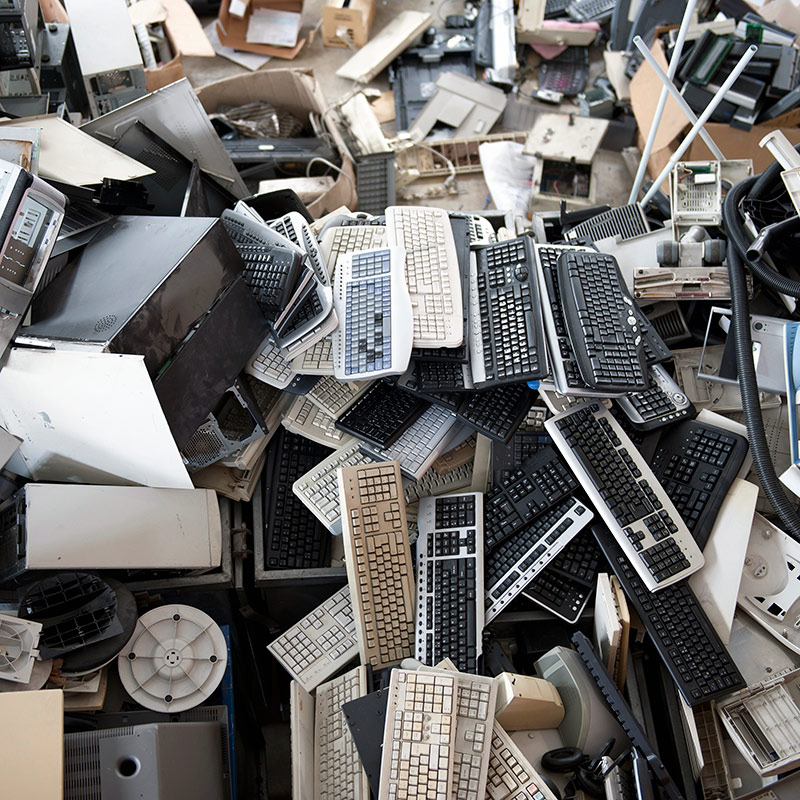
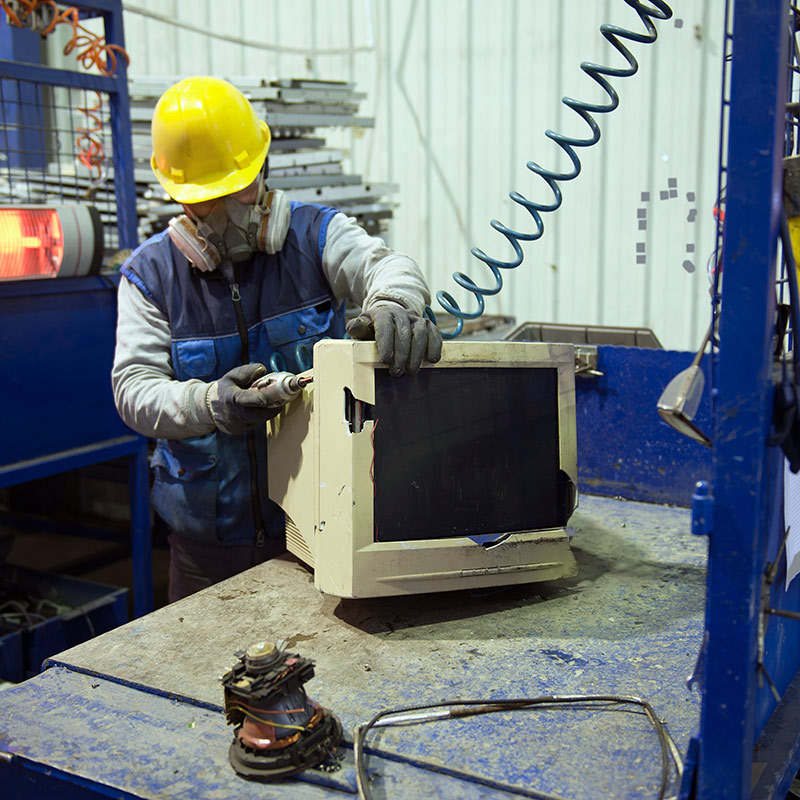
Are BFR plastics recyclable and do they impact the properties of recycled WEEE Plastics?
BFR containing plastics resins (HIPS and ABS) are recyclable. Several studies have been undertaken over the past decade that clearly demonstrate they are recyclable. Recyclers market high value polymers containing BFRs originally added to the virgin polymer – thereby saving resources.
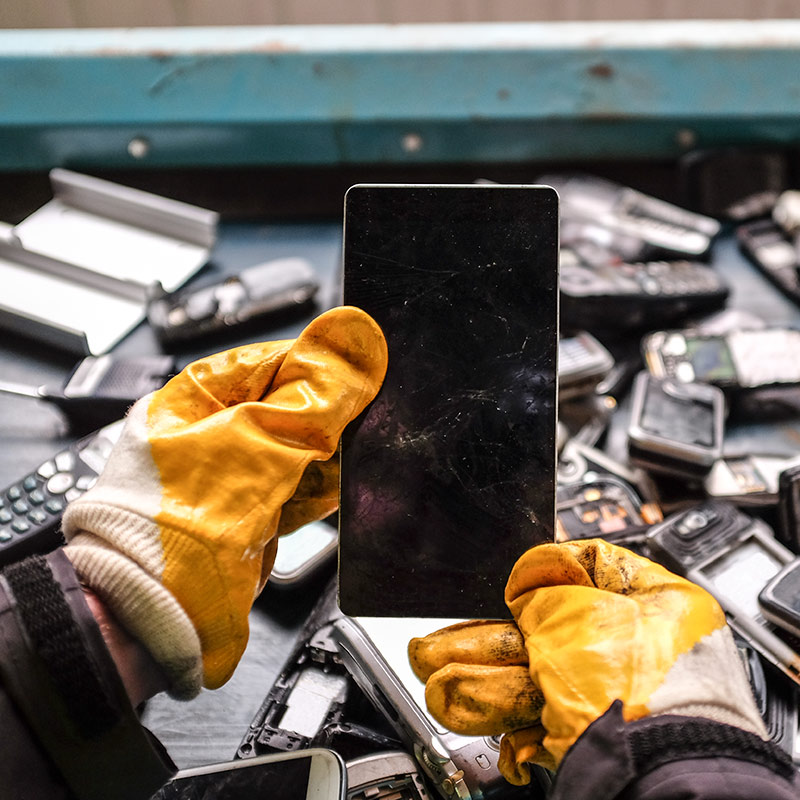
Are there new technological developments that can further reduce the loss of plastics materials containing brominated flame retardants?
While there are established solutions for recovering the metal fractions, the recycling of mixed plastics into clean, recyclable plastic flakes is a major challenge (Maisel, et. Al, 2020). The reasons for this are in particular the high complexity of the plastic mixture (more than 15 different polymer types) as well as additives such as fillers, stabilisers, colours and flame retardants.
A key step which will greatly help improve plastics recycling from WEEE is improved sorting and sorting technologies. Recent research under the EU funded PolyCE project has identified improvements if attention is paid to sizing of plastics particles. Through efficient sorting, the separation can be more effective and the recyclability increased in terms of plastic recycling as there would be less material for landfilling and incinerating (Maisel, et. Al. op.cit).
To compliment improved sorting and to specifically address additives in the polymers including FRs and BFRs, dissolution technologies are potentially an exciting option. A particularly relevant example here is the “Close WEEE Project” co-funded under the EU’s Horizon 2020 programme.
Close WEEE explored using a physical dissolution technology – the CreaSolv® Process – a technique developed by Creacycl GmBH and the Fraunhofer Institute in Germany. The summary results indicate a proof of concept with the separation approach for plastics such as ABS, HIPS, and BFR/antimony verified in laboratory and small technical scale. Using this technology at scale would be a more feasible and better option than incineration.
Other projects such PLASTIC2bCLEANED (lab scale) and PSLOOP (demo plant) are all additional examples of the industry value chain’s drive to improve the quality of recycled plastics from WEEE and other products. The EU is supporting all these initiatives to the tune of some 20 Million euros.
Expanded Polystyrene containing a phased-out BFR
Proper management of construction and demolition waste and recycled materials – including the correct handling of hazardous waste – can have major benefits in terms of sustainability and the quality of life. But it also can provide major benefits for the EU construction and recycling industry, as it boosts demand for C&D recycled materials.
In the EU, the Waste Framework Directive 2008/98/EC aims to have 70% of Construction and Demolition waste recycled by 2020. However, with the exception of a few EU countries, only about 50% of C&D waste is currently being recycled.
With respect to brominated flame retardants, one in particular has been widely used since the 1960s in foam insulation boards – HBCD. However, HBCD is restricted globally as a POP substance. It can therefore no longer be used and has been replaced by another, more sustainable alternative designed specifically for use in insulation foams. Because HBCD is now a POP, it means that material containing it is potentially hazardous, and may only be disposed of in a way which assures complete destruction of the POP substance. Millions of tons of polystyrene foam waste can therefore no longer be recycled.
However, in 2017 the EU LIFE program awarded funding to a unique value chain initiative – The PolyStyreneLoop. It is an innovative recycling project aiming to contribute to the circular economy by introducing a recycling scheme for Polystyrene foams containing HBCD using advanced chemical recycling processes. A physical-chemical recycling process can now preserve the highquality PS, to be used again as raw material for new foams. In parallel, this process safely removes the flame retardant HBCD from PS foam. The HBCD is destroyed in a hazardous waste incinerator equipped with a Bromine Recovery Unit (BRU). This facility ensures the safe recovery of the valuable bromine component, to be used for new polymeric flame retardants.



